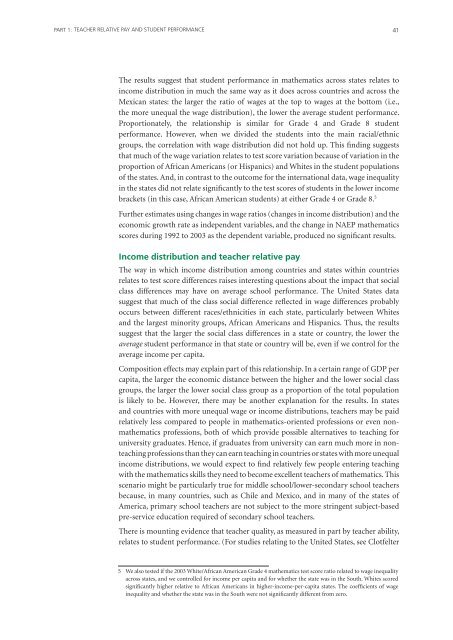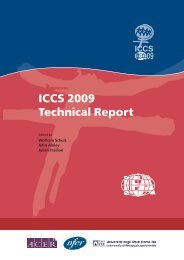Teacher Education and Development Study in Mathematics - IEA
Teacher Education and Development Study in Mathematics - IEA
Teacher Education and Development Study in Mathematics - IEA
Create successful ePaper yourself
Turn your PDF publications into a flip-book with our unique Google optimized e-Paper software.
PART 1: TEACHER RELATIVE PAY AND STUDENT PERFORMANCE<br />
41<br />
The results suggest that student performance <strong>in</strong> mathematics across states relates to<br />
<strong>in</strong>come distribution <strong>in</strong> much the same way as it does across countries <strong>and</strong> across the<br />
Mexican states: the larger the ratio of wages at the top to wages at the bottom (i.e.,<br />
the more unequal the wage distribution), the lower the average student performance.<br />
Proportionately, the relationship is similar for Grade 4 <strong>and</strong> Grade 8 student<br />
performance. However, when we divided the students <strong>in</strong>to the ma<strong>in</strong> racial/ethnic<br />
groups, the correlation with wage distribution did not hold up. This f<strong>in</strong>d<strong>in</strong>g suggests<br />
that much of the wage variation relates to test score variation because of variation <strong>in</strong> the<br />
proportion of African Americans (or Hispanics) <strong>and</strong> Whites <strong>in</strong> the student populations<br />
of the states. And, <strong>in</strong> contrast to the outcome for the <strong>in</strong>ternational data, wage <strong>in</strong>equality<br />
<strong>in</strong> the states did not relate significantly to the test scores of students <strong>in</strong> the lower <strong>in</strong>come<br />
brackets (<strong>in</strong> this case, African American students) at either Grade 4 or Grade 8. 5<br />
Further estimates us<strong>in</strong>g changes <strong>in</strong> wage ratios (changes <strong>in</strong> <strong>in</strong>come distribution) <strong>and</strong> the<br />
economic growth rate as <strong>in</strong>dependent variables, <strong>and</strong> the change <strong>in</strong> NAEP mathematics<br />
scores dur<strong>in</strong>g 1992 to 2003 as the dependent variable, produced no significant results.<br />
Income distribution <strong>and</strong> teacher relative pay<br />
The way <strong>in</strong> which <strong>in</strong>come distribution among countries <strong>and</strong> states with<strong>in</strong> countries<br />
relates to test score differences raises <strong>in</strong>terest<strong>in</strong>g questions about the impact that social<br />
class differences may have on average school performance. The United States data<br />
suggest that much of the class social difference reflected <strong>in</strong> wage differences probably<br />
occurs between different races/ethnicities <strong>in</strong> each state, particularly between Whites<br />
<strong>and</strong> the largest m<strong>in</strong>ority groups, African Americans <strong>and</strong> Hispanics. Thus, the results<br />
suggest that the larger the social class differences <strong>in</strong> a state or country, the lower the<br />
average student performance <strong>in</strong> that state or country will be, even if we control for the<br />
average <strong>in</strong>come per capita.<br />
Composition effects may expla<strong>in</strong> part of this relationship. In a certa<strong>in</strong> range of GDP per<br />
capita, the larger the economic distance between the higher <strong>and</strong> the lower social class<br />
groups, the larger the lower social class group as a proportion of the total population<br />
is likely to be. However, there may be another explanation for the results. In states<br />
<strong>and</strong> countries with more unequal wage or <strong>in</strong>come distributions, teachers may be paid<br />
relatively less compared to people <strong>in</strong> mathematics-oriented professions or even nonmathematics<br />
professions, both of which provide possible alternatives to teach<strong>in</strong>g for<br />
university graduates. Hence, if graduates from university can earn much more <strong>in</strong> nonteach<strong>in</strong>g<br />
professions than they can earn teach<strong>in</strong>g <strong>in</strong> countries or states with more unequal<br />
<strong>in</strong>come distributions, we would expect to f<strong>in</strong>d relatively few people enter<strong>in</strong>g teach<strong>in</strong>g<br />
with the mathematics skills they need to become excellent teachers of mathematics. This<br />
scenario might be particularly true for middle school/lower-secondary school teachers<br />
because, <strong>in</strong> many countries, such as Chile <strong>and</strong> Mexico, <strong>and</strong> <strong>in</strong> many of the states of<br />
America, primary school teachers are not subject to the more str<strong>in</strong>gent subject-based<br />
pre-service education required of secondary school teachers.<br />
There is mount<strong>in</strong>g evidence that teacher quality, as measured <strong>in</strong> part by teacher ability,<br />
relates to student performance. (For studies relat<strong>in</strong>g to the United States, see Clotfelter<br />
5 We also tested if the 2003 White/African American Grade 4 mathematics test score ratio related to wage <strong>in</strong>equality<br />
across states, <strong>and</strong> we controlled for <strong>in</strong>come per capita <strong>and</strong> for whether the state was <strong>in</strong> the South. Whites scored<br />
significantly higher relative to African Americans <strong>in</strong> higher-<strong>in</strong>come-per-capita states. The coefficients of wage<br />
<strong>in</strong>equality <strong>and</strong> whether the state was <strong>in</strong> the South were not significantly different from zero.

















